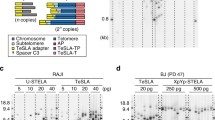Abstract
Length is a functional parameter of telomeres, the nucleoprotein structures that protect chromosome ends. The availability of highly specific, high affinity probes for telomeric repeat sequences allowed the development of quantitative approaches aimed at measuring telomere length directly on chromosomes or in interphase nuclei. Here, we describe a general method for telomere quantitative FISH on metaphase chromosomes and discuss its most common applications in research.
Access this chapter
Tax calculation will be finalised at checkout
Purchases are for personal use only
Similar content being viewed by others
References
Abdallah P, Luciano P, Runge KW, Lisby M, Geli V, Gilson E, Teixeira MT (2009) A two-step model for senescence triggered by a single critically short telomere. Nat Cell Biol 11:988–993
Der-Sarkissian H, Bacchetti S, Cazes L, Londono-Vallejo JA (2004) The shortest telomeres drive karyotype evolution in transformed cells. Oncogene 23:1221–1228
Hemann MT, Strong MA, Hao LY, Greider CW (2001) The shortest telomere, not average telomere length, is critical for cell viability and chromosome stability. Cell 107:67–77
de Lange T (2005) Shelterin: the protein complex that shapes and safeguards human telomeres. Genes Dev 19:2100–2110
Liu D, O’Connor MS, Qin J, Songyang Z (2004) Telosome, a mammalian telomere-associated complex formed by multiple telomeric proteins. J Biol Chem 279:51338–51342
Palm W, de Lange T (2008) How shelterin protects mammalian telomeres. Annu Rev Genet 42:301–334
de Lange T (2009) How telomeres solve the end-protection problem. Science 326:948–952
Lingner J, Cooper JP, Cech TR (1995) Telomerase and DNA end replication: no longer a lagging strand problem? Science 269:1533–1534
Hug, N., and Lingner, J. (2006) Telomere length homeostasis, Chromosoma.
Forsyth NR, Wright WE, Shay JW (2002) Telomerase and differentiation in multicellular organisms: Turn it off, turn it on, and turn it off again. Differentiation 69:188–197
Shay JW, Wright WE (2005) Senescence and immortalization: role of telomeres and telomerase. Carcinogenesis 26:867–874
Kappei D, Londono-Vallejo JA (2008) Telomere length inheritance and aging. Mech Ageing Dev 129:17–26
Armanios M (2009) Syndromes of telomere shortening. Annu Rev Genomics Hum Genet 10:45–61
Aubert G, Lansdorp PM (2008) Telomeres and aging. Physiol Rev 88:557–579
Levy MZ, Allsopp RC, Futcher AB, Greider CW, Harley CB (1992) Telomere end-replication problem and cell aging. J Mol Biol 225:951–960
Kipling D, Cooke HJ (1990) Hypervariable ultra-long telomeres in mice. Nature 347:400–402
Cawthon RM (2009) Telomere length measurement by a novel monochrome multiplex quantitative PCR method. Nucleic Acids Res 37:e21
Gil ME, Coetzer TL (2004) Real-time quantitative PCR of telomere length. Mol Biotechnol 27:169–172
Zou Y, Sfeir A, Gryaznov SM, Shay JW, Wright WE (2004) Does a sentinel or a subset of short telomeres determine replicative senescence? Mol Biol Cell 15:3709–3718
Jeyapalan JC, Ferreira M, Sedivy JM, Herbig U (2007) Accumulation of senescent cells in mitotic tissue of aging primates. Mech Ageing Dev 128:36–44
Londono-Vallejo JA, DerSarkissian H, Cazes L, Thomas G (2001) Differences in telomere length between homologous chromosomes in humans. Nucleic Acids Res 29:3164–3171
Baird DM, Rowson J, Wynford-Thomas D, Kipling D (2003) Extensive allelic variation and ultrashort telomeres in senescent human cells. Nat Genet 33:203–207
Lansdorp PM, Verwoerd NP, van de Rijke FM, Dragowska V, Little MT, Dirks RW, Raap AK, Tanke HJ (1996) Heterogeneity in telomere length of human chromosomes. Hum Mol Genet 5:685–691
Graakjaer J, Pascoe L, Der-Sarkissian H, Thomas G, Kolvraa S, Christensen K, Londoño-Vallejo J (2004) The relative lengths of individual telomeres are defined in the zygote and strictly maintained during life. Aging Cell 3:97–102
Graakjaer J, Der-Sarkissian H, Schmitz A, Bayer J, Thomas G, Kolvraa S, Londono-Vallejo JA (2006) Allele-specific relative telomere lengths are inherited. Hum Genet 119:344–350
Londono-Vallejo JA (2004) Telomere length heterogeneity and chromosome instability. Cancer Lett 212:135–144
Cerone MA, Londoño-Vallejo JA, Bacchetti S (2001) Telomere maintenance by telomerase and by recombination can coexist in human cells. Hum Mol Genet 10:1945–1952
Cerone MA, Ward RJ, Londono-Vallejo JA, Autexier C (2005) Telomerase RNA mutated in autosomal dyskeratosis congenita reconstitutes a weakly active telomerase enzyme defective in telomere elongation. Cell Cycle 4:585–589
Marie-Egyptienne DT, Cerone MA, Londono-Vallejo JA, Autexier C (2005) A human-Tetrahymena pseudoknot chimeric telomerase RNA reconstitutes a nonprocessive enzyme in vitro that is defective in telomere elongation. Nucleic Acids Res 33:5446–5457
Poon SS, Martens UM, Ward RK, Lansdorp PM (1999) Telomere length measurements using digital fluorescence microscopy. Cytometry 36:267–278
Arnoult N, Shin-Ya K, Londono-Vallejo JA (2008) Studying telomere replication by Q-CO-FISH: the effect of telomestatin, a potent G-quadruplex ligand. Cytogenet Genome Res 122:229–236
Silahtaroglu A, Pfundheller H, Koshkin A, Tommerup N, Kauppinen S (2004) LNA-modified oligonucleotides are highly efficient as FISH probes. Cytogenet Genome Res 107:32–37
Baird DM, Coleman J, Rosser ZH, Royle NJ (2000) High levels of sequence polymorphism and linkage disequilibrium at the telomere of 12q: implications for telomere biology and human evolution. Am J Hum Genet 66:235–250
Coleman J, Baird DM, Royle NJ (1999) The plasticity of human telomeres demonstrated by a hypervariable telomere repeat array that is located on some copies of 16p and 16q. Hum Mol Genet 8:1637–1646
Gilson E, Londono-Vallejo A (2007) Telomere length profiles in humans: all ends are not equal. Cell Cycle 6:2486–2494
Arnoult N, Saintome C, Ourliac-Garnier I, Riou JF, Londono-Vallejo A (2009) Human POT1 is required for efficient telomere C-rich strand replication in the absence of WRN. Genes Dev 23:2915–2924
Acknowledgments
Work in the Londoño laboratory is supported by “La Ligue contre le Cancer”, the “Fondation pour la Recherche Medicale, FRM”, the “Association pour la Recherche sur le Cancer, ARC”. I. O-G. was the recipient of a PhD fellowship from Agence Nationale de la Recherche (ANR) and ARC.
Author information
Authors and Affiliations
Corresponding author
Editor information
Editors and Affiliations
Rights and permissions
Copyright information
© 2017 Springer Science+Business Media LLC
About this protocol
Cite this protocol
Ourliac-Garnier, I., Londoño-Vallejo, A. (2017). Telomere Length Analysis by Quantitative Fluorescent in Situ Hybridization (Q-FISH). In: Songyang, Z. (eds) Telomeres and Telomerase. Methods in Molecular Biology, vol 1587. Humana Press, New York, NY. https://doi.org/10.1007/978-1-4939-6892-3_3
Download citation
DOI: https://doi.org/10.1007/978-1-4939-6892-3_3
Published:
Publisher Name: Humana Press, New York, NY
Print ISBN: 978-1-4939-6891-6
Online ISBN: 978-1-4939-6892-3
eBook Packages: Springer Protocols




